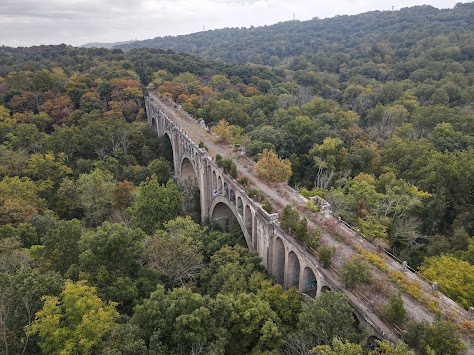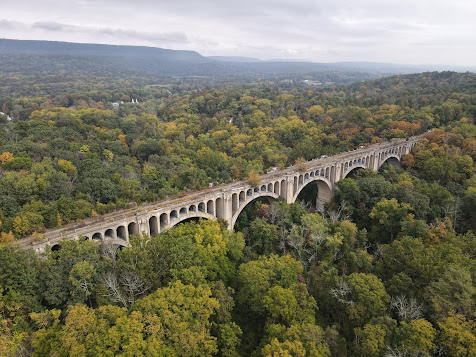The early 1900s was a
period of great expansion and construction when it comes to America’s
railroads. During the period of 1909-1915, the Delaware, Lackawanna, &
Western Railroad (or DL&W, or Lackawanna for short) oversaw the construction
of four monstrous reinforced concrete bridges across northwest New Jersey and
northeast Pennsylvania to serve its new Lackawanna Cut Off and Summit Cut Off
tracks along the New York to Binghamton freight rail service. In due course, we’re
going to discuss these four landmark structures, their local/regional significance,
and how you can view & experience them up close (legally) for yourself.
We’ll begin near the town
of Hainesburg, NJ and the Paulinskill Viaduct, located a short distance from NJ
Route 94 a few miles east of Columbia. Built in 1910, this bridge spans the Paulins
Kill Valley with an overall length of about 1,100 ft with a height of up to 115
ft above the valley floor. To help span the valley, it features seven concrete
arch spans of 120 ft each. It was the largest reinforced concrete bridge in the
world when built, surpassing its nearby counterpart on the Delaware River.
Since reinforced concrete was not yet a widespread building material, this
bridge’s construction made headlines within the global engineering community
for its groundbreaking widespread use of the material. It has proven to be an
extremely durable and strong structure that continues to stand the test of time
over a century after being built.
The Paulinskill Viaduct
carried rail traffic into the 1970s, when the line was finally abandoned and
the bridge fell into disrepair. The train tracks and rail bed were removed in
the 1980s and no other modifications have been made to the structure since.
Plans are currently in the works to restore this bridge to its former glory be
reinstating passenger rail service along the Lackawanna Cut Off as part of a
proposed commuter rail line extension toward Stroudsburg and Scranton, however nothing
appears to be imminent on that front at this time.
Long popular with urban
explorers since its abandonment in the 1980s, this bridge is difficult to view
in full from ground level – it requires legal aerial photography methods in
order to fully take in the scale of this structure. Even so, mother nature has
gradually overtaken this bridge in the past century with much of the structure now
shrouded or hidden by the surrounding wilderness, which makes it difficult to
appreciate the size of the structure in its expansive location. In response to
the long-time problems in the area with trespassers, the New Jersey State
Police is said to patrol the area on a regular basis. The most legal and
straight-forward way to explore this bridge is to view it from Station Road a
short distance south of NJ 94 in Hainesburg. The road passes beneath the
structure and is home to multiple roadside interpretive signs outlining the
history of the area and its signature bridge.
The photos you're about to look through below were all taken legally with the use of a quadcopter drone. Always remember to explore your favorite landmarks in a safe, legal, and responsible manner.



















Comments